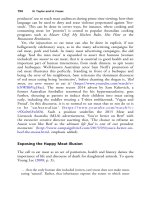The palgrave international handbook of a 462
Bạn đang xem bản rút gọn của tài liệu. Xem và tải ngay bản đầy đủ của tài liệu tại đây (27.05 KB, 1 trang )
464
R. Sollund
Even if animals survive their abduction and transport, there is no guarantee
that they will receive proper treatment—that is, be given adequate food and
shelter, stimuli, company, room for exercise—once they reach their final
destination. In South America, captured birds are often left to die of malnutrition because they can be easily replaced. In Norway, pet owners do not need
to demonstrate to sellers that they are capable of giving an animal proper care
and attention (Sollund 2013c). There is a requirement in the Norwegian
Animal welfare act’s § 6 about competence in animal keeping for those who
shall take over an animal;12 however, private owners selling or giving away
their animals and the people who take them on are not controlled. So, for
instance, traumatized birds, who are also fed with the wrong food, are victims
of abuse because of the damage this does to their physical and mental health.
In the case of reptiles, transport often proves very harmful. They are often
trafficked in boxes and sent from their habitat to Europe by mail/package
service. As many originate in Indonesia, the journey is long and many die in
transit or shortly after arriving (see Herbig 2010). In the numerous penal cases
I examined that concern reptiles, photos and the description of how the
reptiles are kept confirm that they endure less than ideal living conditions,
such as being contained in small, bare glass boxes while in transit. This
constitutes suffering because naturally many reptile species roam great distances and have needs in regards to physical movement and also the mental
stimulation they get from finding food. In one case, the offenders explained to
the police that they took over a boa snake for a friend, and it was evident from
what they said that care for the animal was of low priority. Offenders pose in
pictures with the snakes wrapped around their bodies, thus using them as
artefacts to display some sort of status, perhaps related to masculinity ideals,
rather than caring for the animals involved. Paradoxically, what may add to
the inadequate care reptiles receive is the fact that because it is illegal to keep
them in Norway, partly for animal welfare reasons, owners are hesitant to
bring them to a veterinarian because they are afraid they will be reported, and
when they do, veterinarians do not always provide adequate treatment
because they lack experience, while others refuse to treat them entirely.
It must be emphasized though, that many reptile keepers care for their
animals and try to provide living conditions for their pets which they find
appropriate (interview data). Still, the question remains whether any ‘wild’
12
According to § 6, animal keepers must ensure animals are adequately taken care of, no children under
16 shall have an independent responsibility for an animal, and the animal keeper must not transfer the
responsibility for the animal to someone for whom it is reason to believe will not treat the animal in a
responsible way. />









